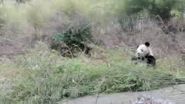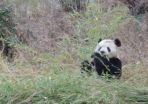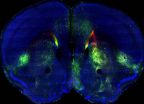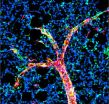(Press-News.org) VIDEO:
A panda in the Wolong Nature Reserve munches on bamboo -- which comprises 99 percent of the endangered species' diet in the wild.
Click here for more information.
Pandas, it turns out, aren't celebrating the Year of the Horse.
Livestock, particularly horses, have been identified as a significant threat to panda survival. The reason: They're beating the pandas to the bamboo buffet. A paper by Michigan State University panda habitat experts published in this week's Journal for Nature Conservation explores an oft-hidden yet significant conflict in conservation.
"Across the world, people are struggling to survive in the same areas as endangered animals, and often trouble surfaces in areas we aren't anticipating," said Jianguo "Jack" Liu, Rachel Carson Chair in Sustainability at Michigan State University (MSU). "Creating and maintaining successful conservation policy means constantly looking for breakdowns in the system. In this case, something as innocuous as a horse can be a big problem."
China invests billions to protect giant panda habitat and preserve the 1,600 remaining endangered wildlife icons living there. For years, timber harvesting has been the panda's biggest threat. Pandas have specific habitat needs – they eat only bamboo and stay in areas with gentle slopes that are far from humans. Conservation programs that limit timber harvesting have chalked up wins in preserving such habitat.
Vanessa Hull, a doctoral student in MSU's Center for Systems Integration and Sustainability (CSIS), has been living off and on for seven years in the Wolong Nature Reserve, most recently tracking pandas she's equipped with GPS collars. She has been working to better understand how these elusive and isolated animals move about and use natural resources.
Over the years, she started noticing it wasn't just pandas chowing on bamboo.
"It didn't take particular panda expertise to know that something was amiss when we'd come upon horse-affected bamboo patches. They were in the middle of nowhere and it looked like someone had been in there with a lawn mower," Hull said.
Alarmed by the growing devastation, she learned that some of Wolong's farmers, who traditionally hadn't kept horses, had been talking to friends outside of the reserve who had been cashing in by raising them. A horse there, Hull said, is kind of a bank account. Horses were barred from designated grazing areas because they competed with cattle, so farmers would let them graze unattended in the forests. When funds were needed, they would track the animals down and sell them.
It was an idea whose popularity skyrocketed. In 1998, only 25 horses lived in Wolong. By 2008, 350 horses lived there in 20 to 30 herds.
To understand the scope of the problem, Hull and her colleagues put the same type of GPS collars they were using to track pandas on one horse in each of the four herds they studied. Then over a year they compared their activity with that of three collared adult pandas in some of the same areas and combined it with habitat data.
They discovered that horses are indeed big on bamboo – and also are drawn to the same sunny, gently sloped spots as pandas. Pandas and horses eat about the same amount of bamboo, but a herd of more than 20 horses made for a feeding frenzy, decimating areas the reserve was established to protect.
This horse problem has been resolved. The researchers presented their findings to Wolong's managers, who have since banned horses from the reserve. But Hull and Liu note that this work has shed light on how competitive livestock can be in sensitive habitat – an issue that is repeated across the globe.
"Livestock affect most of the world's biodiversity hotspots," Liu said. "They make up 20 percent of all of the earth's land mammals and therefore monopolize key resources needed to maintain the earth's fragile ecosystems."
INFORMATION:
In addition to Liu and Hull, "Impact of Livestock on Giant Pandas and their Habitat" was authored by CSIS members Jindong Zhang, a postdoctoral research assistant; and assistant professor Andrés Viña; CSIS alumni Wei Liu and Mao-Ning Tuanmu; Shiqiang Zhou, Jinyan Huang, Rengui Li, Dian Liu, Yan Huang;, and Hemin Zhang of the China Center for Research and Conservation of the Giant Panda in Wolong; and Zhiyun Ouyang and Weihua Xu of the State Key Laboratory of Urban and Regional Ecology, Research Center for Eco-environmental Sciences, Chinese Academy of Sciences in Beijing.
The research was funded by the National Science Foundation, NASA, the Michigan State University Distinguished Fellowship Program, the William and Evelyn Taylor International Engagement Program, an International Association for Bear Research and Management Research and Conservation Grant, the National Natural Science Foundation of China, the State Key Laboratory of Urban and Regional Ecology, Research Center for Eco-Environmental Sciences, Chinese Academy of Sciences, and the Giant Panda International Collaboration Fund.
Livestock found ganging up on pandas at the bamboo buffet
2014-02-27
ELSE PRESS RELEASES FROM THIS DATE:
Making treatment of rare blood disorder more affordable and effective
2014-02-27
PHILADELPHIA — A University of Pennsylvania research team has defined a possible new way to fight a disease that is currently treatable only with the most expensive drug available for sale in the United States. In a study published this month in Blood, the Penn team describes the strategy, based on the oldest part of the human immune system – called "complement" -- that could turn out to be less costly and more effective for the majority of patients with a rare blood disorder.
Complement is a network of more than 50 proteins in the blood and on cell surfaces that quietly ...
International study shows majority of children unaware of cigarette warning labels
2014-02-27
College Park, Md. -- An international study of children's perceptions of cigarette package warning labels found that the majority of children are unaware that they exist. Children in countries where larger warning labels are used, and which include a compelling graphic image of the negative health impacts of smoking, were more likely to be aware of and understand the health risks of tobacco products.
The study, led by Dina Borzekowski, Ed.D, in the University of Maryland School of Public Health (UMD SPH), and Joanna Cohen, PhD, Johns Hopkins Bloomberg School of Public ...
AGU: A 'shark's eye' view: Witnessing the life of a top predator
2014-02-27
HONOLULU – Instruments strapped onto and ingested by sharks are revealing novel insights into how one of the most feared and least understood ocean predators swims, eats and lives.
For the first time, researchers at the University of Hawaii and the University of Tokyo outfitted sharks with sophisticated sensors and video recorders to measure and see where they are going, how they are getting there, and what they are doing once they reach their destinations. (Go to http://www.youtube.com/watch?v=UHDOAmXRw-0&feature=youtu.be for video).
Scientists are also piloting ...
Mouse brain atlas maps neural networks to reveal how brain regions interact
2014-02-27
Different brain regions must communicate with each other to control complex thoughts and behaviors, but relatively little is known about how these areas organize into broad neuronal networks. In a study published by Cell Press February 27th in the journal Cell, researchers developed a mouse whole-brain atlas that reveals hundreds of neuronal pathways in a brain structure called the cerebral cortex. The online, open access, interactive image database, called the Mouse Connectome Project, provides an invaluable resource for researchers interested in studying the anatomy and ...
Study uncovers why autism is more common in males
2014-02-27
Males are at greater risk for neurodevelopmental disorders, such as autism spectrum disorder (ASD), than females, but the underlying reasons have been unclear. A large cohort study published by Cell Press on February 27th in the American Journal of Human Genetics provides compelling evidence in support of the "female protective model," which proposes that females require more extreme genetic mutations than do males to push them over the diagnostic threshold for neurodevelopmental disorders.
"This is the first study that convincingly demonstrates a difference at the molecular ...
Male goat essence really turns the females on
2014-02-27
Anyone who has ever spent time around goats knows they have a certain smell. By carefully analyzing eau de male goat, researchers reporting in the Cell Press journal Current Biology on February 27 have now identified a novel, citrus-scented ingredient that speaks directly to the females. It acts on female goats' brains to turn their reproductive systems on.
The study is the first to uncover a pheromone that activates the central reproductive axis, according to the researchers. Although the work was done in goats, the researchers say there is reason to think the findings ...
Supplement added to a standard diet improves health and prolongs life in mice
2014-02-27
Activating a protein called sirtuin 1 extends lifespan, delays the onset of age-related metabolic diseases, and improves general health in mice. The findings, which appear online February 27 in the Cell Press journal Cell Reports, point to a potentially promising strategy for improving health and longevity.
Sirtuin 1, or SIRT1, is known to play an important role in maintaining metabolic balance in multiple tissues, and studies in various organisms have shown that activating the protein can lead to many health benefits. Also, drugs that increase SIRT1 activity have been ...
By zooming in on arteries, researcher gets to the root of pulmonary hypertension
2014-02-27
You might think building muscle is a good thing, but that's often not so in the case of blood vessels in adults. In fact, excess smooth muscle is a root problem in many vascular diseases, as it causes arteries to constrict and blood pressure to rise. Now, an in-depth analysis of arterioles in mice with pulmonary hypertension explains how those misplaced smooth muscle cells develop.
The findings reported in the Cell Press journal Cell Reports on February 27th are important because nearly half of patients with pulmonary hypertension die within three years of diagnosis, ...
Yale study provides a breath of hope for pulmonary hypertension patients
2014-02-27
Most of us draw roughly 25,000 breaths a day without any thought. But for patients with pulmonary hypertension, a life-threatening increase in blood pressure in the lungs, even the smallest task can leave them gasping for air. A new study by researchers at Yale School of Medicine offers insight into the function of cells linked to this incurable and often fatal illness.
Published Feb. 27 in Cell Reports, the study is the first to explore the cellular mechanisms behind the changes in the way cells are organized in pulmonary arteries in pulmonary hypertension, which leaves ...
Internal logic: 8 distinct subnetworks in mouse cerebral cortex
2014-02-27
The mammalian cerebral cortex, long thought to be a dense single interrelated tangle of neural networks, actually has a "logical" underlying organizational principle, reveals a study appearing Feb. 27 in the journal Cell.
Researchers have identified eight distinct neural subnetworks that together form the connectivity infrastructure of the mammalian cortex, the part of the brain involved in higher-order functions such as cognition, emotion and consciousness.
"This study is the first comprehensive mapping of the most developed region of the mammalian brain: the cerebral ...







